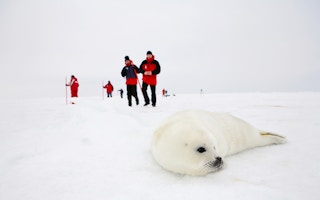Three kinds of whale, six varieties of seal, the walrus and the polar bear all have things in common: they are marine mammals, they depend on the Arctic for survival as species, they are vulnerable, and biologists know surprisingly little about them.
And since the Arctic is warming twice as fast as the rest of the planet, their future could become even more threatened as climate change increases habitat loss.
The stress, so far, is on the word “could”, as the first challenge is to establish the facts.
A global study team led by Kristin Laidre, principal scientist at the University of Washington Polar Science Centre in Seattle, reports in the journal Conservation Biology that marine mammals are “disproportionately threatened and data poor compared with their terrestrial counterparts”.
The narwhal, beluga and bowhead whales, the ringed, bearded, spotted, ribbon, harp and hooded seals, the walrus, and the polar bear are “particularly vulnerable due to their dependence on sea ice”.
Important predators
All these animals make their living on the ice and in waters north of the Arctic Circle, and all are important predators. They are also important to indigenous and settler peoples in the frozen North as many can be legally harvested, and others are iconic tourist attractions. Either way, they help communities survive.
“
We may introduce conservation measures or protected species legislation, but none of those things can really address the primary driver of Arctic climate change and habitat loss for these species. The only thing that can do that is regulation of greenhouse gases.
Kristin Laidre, principal scientist at the University of Washington Polar Science Centre in Seattle
“These species are not only icons of climate change, they are also indicators of ecosystem health, and key resources for humans,” Dr Laidre says. “Accurate scientific data – currently lacking for many species – will be key to making informed and efficient decisions about conservation challenges and trade-offs in the 21st century.”
So the researchers set out on what they believe is the first comprehensive global review of what is known about the populations of these animals, and about the way their local habitats may be changing.
The study divided the Arctic into 12 regions and began to look at population numbers and trends, and the local pattern of seasonal change in the ice.
They identified 78 distinct populations of the 11 species, and began to assemble estimates of numbers. These range from millions for the ringed seals to a few hundred for the beluga whales of Ungava Bay in the Canadian Arctic.
In many cases, researchers had too little information even to make a guess about whether local populations of any species were stable, declining or increasing. In their table of the trends of the 11 species in the 78 populations, the word “unknown” occurs more than 60 times.
They also charted profound reductions in ice cover. The sea ice naturally advances each winter, and retreats each spring, but because of global warming driven by human emissions of greenhouse gases released by fossil fuel combustion, the pattern of advance and retreat has changed dramatically. By 2040, according to some projections, the Arctic could be more or less ice-free each summer.
Extended summer
But change is visible now. In most regions, the scientists found that the summer period was extended by between five and 10 weeks. In Russia’s Barents Sea, the summer ice period is now 20 weeks longer – five months – than it was 30 years ago.
This presents a threat to the polar bear, and to the seals on which they feed. “These animals require sea ice,” Dr Laidre says. “They need ice to find food, find mates, reproduce, and rear their young. It’s their platform of life. It is very clear those species are going to feel the effects the hardest.”
On the other hand, the whale species might benefit – at least for a while – from reduced ice cover. Open water could offer a wider feeding range and greater marine productivity, and therefore more food.
The scientists provide a set of general recommendations for biologists, local authorities, government agencies and international organisations concerned with conservation of Arctic marine mammals. They also have a message for the entire planet.
As Dr Laidre says: “We may introduce conservation measures or protected species legislation, but none of those things can really address the primary driver of Arctic climate change and habitat loss for these species. The only thing that can do that is regulation of greenhouse gases.”

















